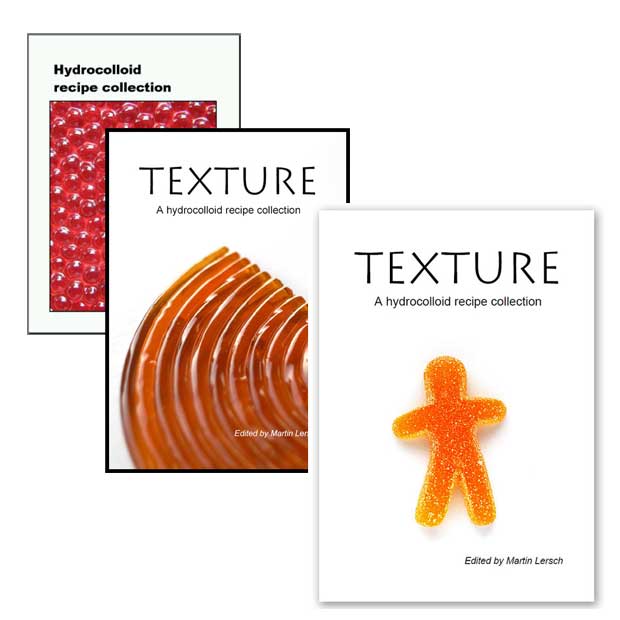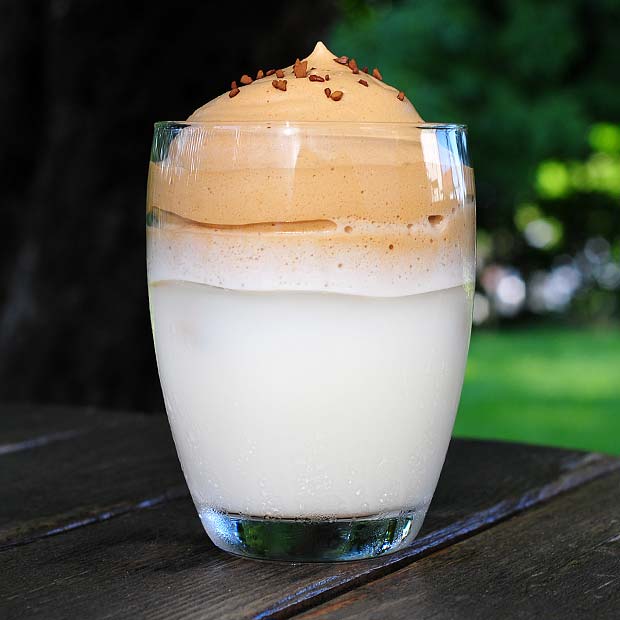
It’s been 6 years since the last update of “Texture – A hydrocolloid recipe collection” and I’m thinking it’s about time for an update. It will be an incremental revision, so expect a v.3.1 were wrinkles have been ironed out, nothing major. I would like to extend a big thank you to all who have provided feedback, pointed out typos and errors and submitted pictures. I may not have replied to you all during the last couple of years, but rest assured that your feedback has been read, is greatly appreciated and will be incorporated! If you have tested a recipe and found that it didn’t work I would very much like to know. And should you have pictures that you haven’t shared yet – now is the time to submit them! If a recipe is accompanied by a photo it’s a good sign that it has been tested with a successful outcome. There is a previous blog post with detailed instructions on how to submit photos (or p. 8 in Texture).
Some hydrocolloids are clearly underrepresented such as guar gum, gum arabic, konjac, locust bean gum and tara gum. I’m in the process of collecting recipes, but if you are aware of recipes that highlight the range of foods each of these hydrocolloids can be used for I would be happy if you share them with me, either in the comments below or directly to hello@khymos.org.
Some hydrocolloids are even completely missing. Some omissions are intentional, such as for proprietary products such as Ultra-Tex and Pure Cote (both are modified starches) and Trisol (a wheat fiber) to mention a few. Others omissions may be accidental if the hydrocolloid is rare or novel. If you have comments, please do let me know.

The category labelled “non-hydrocolloid recipes” includes examples of gels from regional kitchens around the world where no traditional hydrocolloid is added, but where there still is a gelling mechanism creating the unique texture. Examples include Junket, Cuajada, Ginger milk custard, Aiyu jelly, Grass jelly, Gelled seafood sauce, Tofu and Hominy. I’m sure there are more examples of gels (or foams!) that should be included in this section and I need your help to identify them. A foam that certainly will be included in v. 3.1 is the Dalgona coffee foam that took the internet by storm this spring.

i cant wait for the updated new version! when do you think it will be out ?
Ahh, yes … In the mean time I’ve fallen into the coffee rabbit hole, so all my spare time has gone into drinking and researching coffee. I published part 1 today, and there’s more to come. I’m afraid I don’t dare to give any date with regards to Texture. I should mention that I have some ideas for experiments that could be used for benchmarking of viscosities. I do want to explore this as part of the update, so it could take a while – sorry about that!
No worries. i love coffee too and I’m excited to read your post on it. Thanks for replying. I really like your website, it has a lot of great information.
Thank you so much! Always loved your work and this project and I was very happy when you started posting again… Keep on the great work!
Alling’ few years ago we corresponded about the “Gelling” of a seafood sauce (Basically Horseradish, Ketchup and lemon juice). I had observed that on a frequent basis the sauce would Gell up while being in the reach in. I couldn’t predict which combination would trigger the effect. – The ketchup came from various suppliers with no “audit trail back to the processor. However with some speculation I found out that for a time some “commercial processors” used LYE to remove the skins Others use steam. I a not sure if the lye would prevent the pectin from Gelling or if the steam allowed the gelling.
John: Thanks for the comment and sharing your observation! In my blog post on Gelling ketchup with horseradish I speculated about the possible involvement of pectin in this gelling and how the enzyme horseradish peroxidase could possibly be involved in converting high methoxtyl (HM) pectin to low methoxyl (LM) pectin. If tomatoes are peeled with lye this would only affect the surface so I’m not sure how or if this could explain the difference in gelling performance between different brands of ketchup.